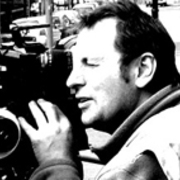
Jono Smith
Jono Smith took an unusual path to becoming a cameraman; he began his career as a teenage actor, starring in the first Kiwi feature invited to the Cannes Film Festival.
Aged 14, Smith had been picked by director Sam Pillsbury to act in The Scarecrow, based on the novel by Ronald Hugh Morrieson. Smith played Ned, the adventurous small towner who suspects the new arrival in town (John Carradine) might be dangerous. The Scarecrow cast would later win an ensemble award for their acting at Mystfest in Italy.
Smith was originally meant to narrate The Scarecrow as well. But on entering the recording studio roughly five months after the shoot, his voice had “dropped three octaves”. So Martyn Sanderson took over the job, playing Ned as an older man, remembering the film’s events.
Smith’s keenness to work in film was fuelled by his Scarecrow experiences, and his high school film society. While still a teen, Smith used film stock, some borrowed from Pillsbury, to dabble in short films. One helped win Smith a job as an assistant trainee at TVNZ in Avalon in 1985, in the days before film schools.
His first task at Avalon was to bulk erase Coronation Streets after broadcast. Smith trained for five years at Avalon as a film cameraman, learning from a cadre of “fine cameramen” including Wayne Vinten and Rocky Hudson.
Smith camera assisted on everything from documentaries (Country Calendar, Kaleidoscope) to drama (Pioneer Women, Marching Girls); the drama was being shot on reversal film. He also witnessed the last, mid 80s days of news footage being shot on film — and the hurried efforts to synchronise picture and sound in time for each night’s broadcast.
In his down time, Smith was also working on other projects. At age 21 he shot his first ‘official’ short film: The Gillian Roberts-directed Scarlet Fever, which revolved around a scarlet dress and a suspicious wife.
Smith also began shooting Hotel Hawkestone, a time-lapse film which chronicled the building of a hotel across the road from his Wellington flat. Made with good friend Sebastian Doyle, the film was shot on a Bolex over three years. Though never seen on local television, Hawkestone won regular screenings on England’s Channel Four. Smith later helped Doyle out on his ambitious stop-motion short The Grocer’s Apprentice.
Seeking more chances to command the camera, Smith spent 1990 with TVNZ news, covering parliament and that year’s election. The following year he crossed over to TV3‘s more anarchic Nightline, where among other things he chronicled Belinda Todd’s adventures acting in Braindead.
Before arriving at TV3, Smith had directed and produced 90 minute music documentary Rock the Quota. Smith helped set up a music festival as part of a campaign to win a 15 per cent quota for Kiwi music on radio and television. Put together by crew from both networks, it was cut overnight at TVNZ, and later screened on TV3, “a true bipartisan production by both broadcasters, even though management never knew it”.
In 1992 Smith set off for his OE. His arrival in London was well timed. Although the English screen industry was facing recession, the newly-launched local arm of Carlton/London Weekend Television needed staff. Smith became a cameraman on daily show London News, then went freelance, shooting many stories for MTV.
In 1995, by now flatting in Brixton, Smith shot his first UK short, Paris, Brixton. The black and white romance marked the first of many collaborations for Smith and Brit director Jeremy Wooding, including the first season of BAFTA-winning comedy Peep Show, and a feature film: Romeo and Juliet-inspired romance Bollywood Queen starred James McAvoy in his first lead role, and was invited to Sundance. Smith had already shot his first (Super 16mm) feature the previous year, little seen science fiction tale Mad Dogs.
Smith’s CV of British television crosses the gamut, including Johnny Rotten in Africa, three seasons of Derren Brown — Trick of the Mind, award-winning BBC drama Desperadoes, plus short Donde Esta Dios, for which he won an award in Spain. He has also worked on music videos for Robbie Williams, and artworks for artist/director Steve McQueen.
Smith has kept up his Kiwi contacts. He has often been the man on the ground when New Zealand TV producers need to shoot in Europe, whether it be a tour by the Topp Twins, or the Cannes launch of Lord of the Rings. Smith also co-directed (with Maree Quinn) Muttonbirds video ‘She’s Been Talking’, shot short film Night of the Hell Hampsters for Kiwi director Paul Campion, and helped shoot images for Kiwi docudrama The Forgotten General.
After time as a partner in successful Brixton-based camera company Shooters, Smith went freelance again in 2008. Since then he has remained in demand for television work, and also shot two more features. 2010’s Sus, which Smith co-produced, is a “riveting” (Daily Mirror) interrogation drama, captured on the Red digital camera. The film is based on the Thatcher-era law (later abolished after the Brixton race riots) which permitted police to search anyone they deemed suspicious. 2014's Blood Moon is a Western/horror movie.
Sources include
Jono Smith
Jonodop website. Accessed 26 October 2015
Susthemovie website (broken link) Accessed 12 September 2011
‘Jono Smith’ - The Internet Movie Database website. Accessed 26 October 2015